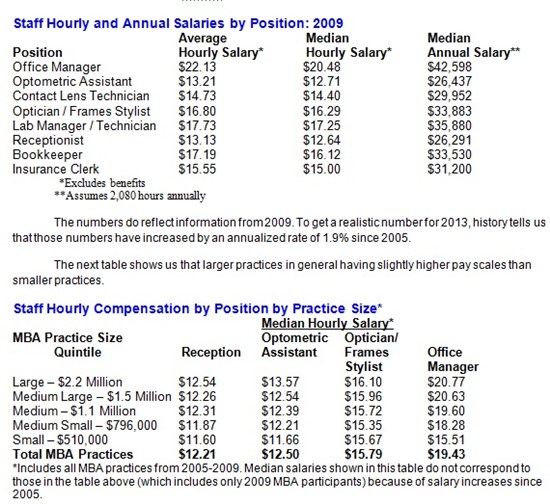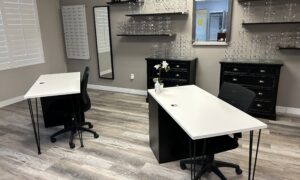By Ken Krivacic, OD, MBA
Tracking and managing your staff costs is a key to practice profitability. The good planning you do equips your staff to provide patients with the superiorlevel of service they deserve.
According to the Management & Business Academy (MBA), sponsored by Essilor, staffing is the second largest expense in an optometric practice. I define staff expenses as any cost related to the employment of personnel needed to run an optometric practice. The two exceptions to this are the cost related to the employment of other ODs and the employment of lab personnel. Doctor salaries would fall under the “net” heading in the budget and the salary of a lab person would fall under the “cost of goods” category.
Staff salaries comprise the largest bulk of the staff expense category. Along with gross wages, I’ve included a list of other expenses incurred as a result of the employment of staff:
- -gross staff wages
- -contract labor
- -employee education
- -payroll expenses
- -staff payroll tax
- -employee benefits (401K plans, profit sharing plans, workman’s comp, medical insurance and other benefits)
Why Does Tracking Staffing Costs Matter?
According to Jerry Hayes, OD, the recommended range of expenses related to staff expenses should be from 15 percent to 20 percent of total revenue. The Management & Business Academy (MBA) sets the range at 15.5 percent to 24.2 percent. It is, therefore, very important to the bottom line that these expenses stay within budget. If it is too high then the extra monies impact the other areas of a practice. In most cases, the largest effect is on net profit. We may think that net profit is only what the ownerdoctor takes home, but it has other impacts. If net is reduced, cash flow is impacted making it harder to pay bills in a timely manner. A reduced net also affects the office’s ability to purchase new goods and new equipment. It could also impact the ability of the office to upgrade, remodel and pay commensurate salaries.
Track “Salary Creep”
The staff expense category has been the weakest link in my practice’s budget for several years. The reason for this is that the majority of our full-time staff has been with us for a long time. Close to half of our employees have been with us for over ten years. This long tenure leads to salary creep. Even a small raise every year leads to a bloated staff expense category.
To counter this we’ve had to establish pay scales for each position in the office. If a long-term employee hits the top of the scale it becomes difficult to continue giving raises. The option for that employee would be to seek a different position in the office in order to increase pay. An example might be moving from an optometric tech position to an optician. To determine if salaries are in line with pay in your community you can refer to web sites such as Payscale.com, Salaries.com and Ask.com.
For our purposes, I prefer to use theMBA information on pay. Below is a list of pay ranges for different positions found on the MBA web site.

Start Tracking Staffing Costs at Beginning of Year
The process for us starts at the beginning of the year. I start with the budget from the previous year and project based on what I feel we can grow for the coming year. Since we are a longstanding office (30+ years) and rather large (close to $2.5 million in revenue in 2012), I estimate our growth rather conservatively at 3 percent per year. This estimate is plugged into an Excel spreadsheet and the projected numbers are used to establish our budget for the upcoming year. This will vary practice to practice depending on length in business and size of practice. Younger and smaller offices will have more room to grow and estimates can be ratcheted up. You may also want to factor in local and national economic outlooks, although personally I tend to focus more on the capability of the office to determine what growth can be.
After the budget is established, I share it with not only the office manager but the entire staff. We have a bi-annual company retreat designed for this purpose so that everyone is on board and working toward the same goal.
Use Yearly Time Frame, But Expect Unexpected
The time frame for the budget is a yearly time frame. Most companies have a yearly plan and we tend to follow that guideline. From there we track the budget monthly to ensure we stay on course.
In the staff expense category we can use the budget to determine when it’s time to add additional personnel. If the percentage in that category is low, you either have a very productive staff or it may be time to add additional personnel. I tend to err on the side of having too many staff as opposed to too little. My philosophy is that a lack of staff leads to lost sales, stressed staff and ultimately a poor patient experience. After all, the ultimate ability of a practice to grow relies on patients having a good experience and returning year after year and referring family and friends. I feel the actions of staff can have as much influence on the success of an office as having a dynamic doctor.
Balance Past Trends with What You Project
I feel you have to start with a budget somewhere. After all, a budget is only a projection of what you want to happen or what you expect to happen. It is not an exact science. Nobody can predict the future and there are many situations that occur throughout a year that can throw you off course. The only thing you know for certain is how you performed last year and this naturally would be your starting point for the next year. You may want to alter the budget slightly based on things you think may happen such as adding another doctor or expanding your space. I would caution not to try to predict too much initially. It is far easier to amend the budget as you proceed through the year, but also keep your original projections as a barometer.
Develop Consistent Staffing Expense Tracking Formula
We try to keep our formula simple by just trying to keep our staff expenses between 20 percent to 26 percent of total income. We have used this projection for years and it is a reasonable number to expect for most optometric practices. As mentioned earlier, Jerry Hayes, OD, of Prima Eye Group,recommends between 15 percent to 20 percent. TheMBA reports a range from its members of between 15.5 percent to 24.2 percent. These numbers can vary depending on size and age of practice.
In our case, the number tends to be on the high end due to a combination of salary creep and a large number of long-term employees. The downside obviously is that our higher percentage of staff expenses eats into net profits. The plus side is relatively low employee turnover which reduces costs involved in recruiting and training new employees. The other benefit is non-financial. Patients comment on the stability of the staff resulting in a more positive patient experience. I like the analogy of a sports team with low turnover of top players. Generally, given good talent, a team can learn to work together and become more cohesive the longer they’ve been together. If you’re constantly changing the roster it’s more difficult to establish continuity.
Tracking the numbers through the budget process alerts us that we need to reevaluate our expenses in that category. So what can be done? There are several options: raises may have to be put on hold, our bonus plan may need to be revamped, benefits may need to be curtailed or staff may need to be reduced. None of these options are easy to enact. Proceed with caution so as not to upset your harmonious workplace if morale is high. On the other hand, if there is a troubling situation with an employee, then letting that person go is easier to do when the budget shows staff expenses are too high.
Track Staffing Costs: Action Plan
Step one is simply to have a staffing budget. Too many practices go through the year without a plan or guideline and then react only when things go bad. You should have a budget and you should write it down.
Implement a pay scale relative to the job position. Most employees equate raises with time at the job. Although this is true to some degree, it will eventually lead to salary creep and a bloated staff expense. Educate your staff on this point.
Pay staff by the hour. Only pay a monthly salary if that person is considered a manager. To avoid potential problems with a state employment commission, an hourly pay for all is what I would recommend–even for managers.
Monitor your budget monthly. Letting things slip can either lead to more apathy and slippage or cause larger problems in the future. Monitoring monthly can also help you recognize trends.
Don’t overreact. Even though you monitor monthly, keep in mind that it is also a long-term project. In the case of staff expenses this may vary monthly depending on the number of employees for that month and the fact that two months of every year will contain three pay periods if you pay on a typical every two week fashion.
Related ROB Articles
Track Your COG: Manage Well for Profitability
Assess End-of-Year Finances and Plan for a Profitable New Year
Add An Additional Exam Lane? Calculate If It’ll Pay Off
Ken Krivacic, OD, is the owner of Las Colinas Vision Center in Irving, Texas. To contact him: kkrivacic@aol.com.



























